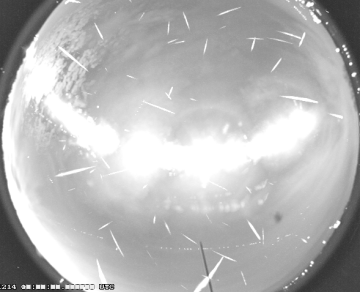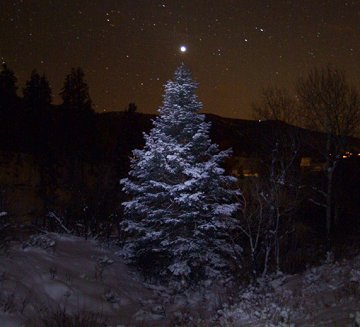| SOLAR FLARE SURPRISE: Solar flares are supposed to obliterate everything in their vicinity, yet one of the most powerful flares of the past 30 years has done just the opposite, emitting a beam of pure and unbroken hydrogen atoms. Researchers think this strange event could yield vital clues to the inner workings of solar flares: full story. GREAT GEMINIDS: The Geminid meteor shower peaked over the weekend and "it was a great show," says NASA astronomer Bill Cooke. "On Saturday night, our all-sky recording system at the Marshall Space Flight Center in Alabama recorded more than 80 bright Geminids in spite of clouds and bright moonlight." Click on the composite image, below, to launch a 4 MB movie: 
Play the movie
Another NASA camera with clearer skies in Georgia recorded even more meteors including a rapid-fire flurry of three at once: movie. "This could be one of the best displays of Geminids we've ever seen," says Cooke. Preliminary counts by the International Meteor Organization indicate that the shower peaked at 160 meteors per hour during the early hours of Dec. 14th. Earth is now exiting the Geminid debris stream and meteor rates are falling--but not yet to zero. Subsiding activity could continue for several nights to come: live updates. UPDATED: 2008 Geminid Meteor Gallery
[previous years: 2007, 2006, 2004, 2002, 2001] CHRISTMAS STAR: Scientific theories aiming to explain the biblical "Christmas Star" frequently include Venus. Look at this picture, taken last night by Colorado astronomer Jimmy Westlake, and you can understand why: 
Photo details: Fuji Finepix S2, ISO 400, 16 mm Nikkor lens at f2.8, 41 seconds
"After a heavy Colorado snowfall, I wandered up into the National Forest behind my house and found a snow-covered spruce tree," says Westlake. "I positioned my camera (a Fuji Finepix S2) and tripod to capture Venus shining at the apex of the spruce. A small flashlight illuminated the foreground. The result is Venus' own Christmas tree." Brilliant Venus is dominating the evening sky this holiday season. Look for it hovering over the treetops after sunset. Venus may not be the Christmas Star, but it's a merry substitute. Happy holidays!
Great Conjunction Photo Gallery | 
